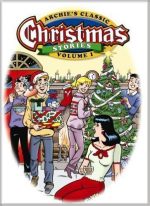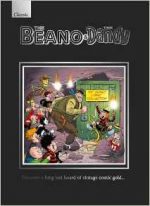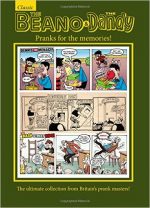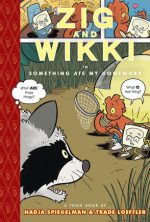
By Willy Lambil & Raoul Cauvin, translated by Erica Jeffrey (Cinebook)
ISBN: 978-1-84918-108-2
The myths and legends of the filmic American West have fascinated Europeans virtually since the actual days of owlhoots and gunfighters. Hergé and Moebius were passionate devotees and the wealth of stand-out Continental comics series ranges from Italy’s Tex Willer to such Franco-Belgian classics as Blueberry and tangential children’s classics such as Yakari. Even colonial dramas such as Pioneers of the New World and Milo Manara & Hugo Pratt’s Indian Summer fit the broad-brimmed bill.
As devised by Louis “Salvé†Salvérius & Raoul Cauvin – who has scripted every best-selling volume – Les Tuniques Bleues (or as we know them The Bluecoats) debuted at the end of the 1960s, specifically created to replace Lucky Luke when the laconic gunslinger defected from weekly anthology Spirou to rival publication Pilote.
The substitute swiftly became one of the most popular bande dessinée series in Europe.
Salvé was a cartoonist of the Gallic big-foot/big-nose humour school, and when he died suddenly in 1972 his replacement, Willy “Lambil†Lambillotte slowly introduced a more realistic – but still overtly comedic – illustrative tone and manner. Lambil is Belgian, born in 1936 and, after studying Fine Art in college, joined publishing giant Dupuis as a letterer in 1952.
Born in 1938, scripter Cauvin is also Belgian and before entering Dupuis’ animation department in 1960 studied Lithography. He soon discovered his true calling – comedy writing – and began a glittering and prolific career at Spirou. In addition to Bluecoats he has written dozens of long-running, award winning series including Cédric, Les Femmes en Blanc and Agent 212: more than 240 separate albums. The Bluecoats alone has sold more than 15 million copies of its 60 (and counting) album series.
As translated for English audiences, our sorry, long-suffering protagonists are Sergeant Cornelius Chesterfield and Corporal Blutch; a pair of worthy fools in the manner of Laurel & Hardy: hapless, ill-starred US cavalrymen posted to the wild frontier and various key points of fabled America during the War Between the States.
The original format featured single-page gags set around an Indian-plagued Wild West fort, but from the second volume Du Nord au Sud (North and South) the sad-sack soldiers went back East to fight in the American Civil War (a tale was rewritten as 18th album Blue rétro to describe how the chumps were drafted during the war).
Every subsequent adventure, although often ranging far beyond America and taking in a lot of thoroughly researched history, is set within the timeframe of the Secession conflict.
Blutch is your run-of-the-mill, whinging little-man-in-the street: work-shy, mouthy, devious and especially critical of the army and its inept commanders. Ducking, diving, even deserting whenever he can, he’s you or me – except sometimes he’s quite smart and heroic if no other (easier) option is available.
Chesterfield is a big burly professional fighting man; a career soldier who has passionately bought into all the patriotism and esprit-de-corps of the Military. He is brave, never shirks his duty and wants to be a hero. He also loves his cynical little troll of a pal. They quarrel like a married couple, fight like brothers and simply cannot agree on the point and purpose of the horrendous war they are trapped in…
Rumberley was the fifth translated Cinebook album (chronologically the 15th Franco-Belgian volume) and a far darker affair than usual. After a horrific battle Union and Confederate forces are spent and exhausted, although the Blues have advanced far into the South as a result of the sustained slaughter. However, with dwindling food and little ammunition the Generals decide to fall back and re-supply with fresh troops and munitions.
The only problem is what to do with the wounded. After all, bringing them back to safety would only slow down the rearward advance…
Then one bright privileged spark has the notion of just billeting the unfit Union soldiers on the nearest – albeit enemy – town…
Amongst the dead and dying are grievously injured Chesterfield and war-crazy Captain Stark. Even Blutch is there, although his leg wound might be minor, self inflicted or possibly even utterly bogus…
Their reception by the women, children, aged and infirm of Rumberley is hostile to say the least, but the Union dregs have no place else to go and no strength left to leave anyway. Forcibly appropriating the livery stable as a field hospital, Blutch and Chesterfield aid the exhausted doctors and surgeons as best they can but the simmering tension and occasional assaults by the townsfolk indicates that there is real trouble brewing and this kettle is about to boil over very soon…
And then the townsfolk start drifting away and rumours spread that a Confederate force is approaching Rumberley. The doctors opt to move their charges out, and Blutch finds himself in the uncanny position of staying behind as rearguard when Chesterfield decides to buy them time to get away…
When it comes, the battle is a bizarre affair. The Rebs are fit but have little ammunition so the Bluecoats give a good accounting of themselves, but are almost done for when Stark unexpectedly leads a life-saving cavalry charge of the Union wounded to save them. During the insane clash the town buildings are set afire and the citizens of Rumberley rush back to save their home and possessions…
And then something strange happens: the killing stops and Blues, Greys and civilians work together to save rather than destroy…
Here is another hugely amusing anti-war saga targeting younger, less world-weary audiences. Historically authentic, and always in good taste despite an uncompromising portrayal of violence, the attitudes expressed by the down-to-earth pair never make battle anything but arrant folly and, like the hilarious yet insanely tragic war-memoirs of Spike Milligan, these are comedic tales whose very humour makes the occasional moments of shocking verity doubly powerful and hard-hitting.
Funny, thrilling, beautifully realised and eminently readable, Bluecoats is the sort of war-story and Western which appeals to the best, not worst, of the human spirit.
© Dupuis 1979 by Lambil & Cauvin. English translation © 2011 Cinebook Ltd. All rights reserved.










